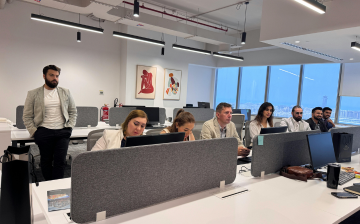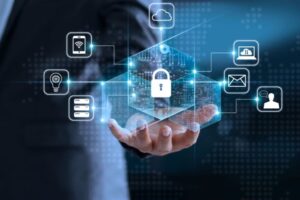
Working in Cybersecurity: A Day in the Life
Working in Cybersecurity: A Day in the Life
Morning Briefing and System Monitoring
A typical day begins by reviewing overnight security alerts. Cybersecurity personnel monitor Security Information and Event Management (SIEM) systems to detect suspicious activity. Analysts check for malware, failed logins, or unusual traffic spikes.
For anyone pursuing a career in cybersecurity, noticing and responding to abnormal activity—such as multiple failed logins from one region—is critical. The team investigates these issues immediately, and early detection helps prevent major security breaches.
Team Stand-Up Meetings
Cybersecurity teams hold daily stand-ups to discuss:
- Ongoing investigations
- Risk management updates
- Urgent issues requiring immediate attention
- Coordination with IT, compliance, and audit teams
Teamwork is essential. Professionals must explain technical risks clearly to management for effective decision-making.
Incident Response and Investigation
If an event appears suspicious, the team responds. Actions may include isolating systems, blocking malicious IP addresses, or examining forensic logs.
Incident response requires patience, careful analysis, and inter-team collaboration. Some incidents involve data loss, while others require regulatory compliance, such as GDPR or RBI guidelines.
Lunch and Industry Updates
During lunch, professionals often read about the latest vulnerabilities, zero-day attacks, or government advisories. Staying informed ensures they remain ahead of evolving threats.
Risk Assessments and Audits
Afternoons often focus on risk management tasks, including:
- Vulnerability scanning
- Reviewing third-party vendor risks
- Evaluating internal security measures
- Preparing audit reports for management
For example, when transferring data to the cloud, professionals assess compliance with security standards and suggest risk-reducing controls.
Knowledge Building and Training
Cybersecurity requires continuous learning. Professionals attend workshops, webinars, or in-house training. Certification courses help them stay updated on tools, frameworks, and strategies.
Documentation and Reporting
At the day’s end, analysts document incidents, fixed vulnerabilities, and discovered risks. Reports reach management and regulators. Proper documentation ensures transparency and improves future responses.
Cybersecurity Skills You Need
To succeed, professionals combine technical and soft skills:
- Technical Knowledge: Networking, firewalls, encryption, cloud security, and endpoint protection
- Risk Awareness: Knowledge of ITGC, SOC reports, and compliance standards
- Analytical Thinking: Understanding logs and errors
- Communication Skills: Explaining technical risks to business leaders
- Continuous Learning: Keeping up with changing threats and tools
A structured cybersecurity course or certification strengthens these skills.
Role of Cyber security Course and Certifications
Certifications demonstrate competence and increase employability. They benefit freshers by:
- Validating skills to employers
- Showing commitment to learning
- Offering practical exposure to real-world scenarios
Some courses only focus on theory. GRMI stands out because it combines theoretical knowledge with practical industry exposure.
GRMI: PGDTRM for Future-Ready Cybersecurity Professionals
Programme Highlights
- Duration: One year (six months classroom, six months paid internship)
- Eligibility: Masters in any field with 0–4 years of work experience
- Hours of Learning: 260+ (180 classroom, 80 project work)
- Industry Exposure: Internships with banks, consultancies, and MNCs
- Salary Potential: ₹6–10 LPA depending on performance
What You Will Learn
- Technology risk management models
- IT General Controls (ITGC)
- Network and data centre security operations
- SOC 1, SOC 2, SOC 3 reports
- Data privacy, compliance, and cybersecurity best practices
Why PGDTRM Stands Out
PGDTRM combines theory with practical application. A six-month paid internship ensures industry exposure. Students receive mentorship from professionals in top companies, preparing them for a real career—not just exams.
PGDTRM Career Opportunities
Completing PGDTRM opens doors to roles such as:
- Cybersecurity Analyst
- IT Auditor
- Technology Risk Consultant
- Compliance Manager
- Risk Advisory Associate
These roles offer job security and professional growth. The demand for qualified professionals will continue to rise as organisations prioritise data protection.
Final Thoughts
Cyber security certification course is not just fighting hackers; it safeguards organisational trust. It is a fast-paced, challenging, and rewarding career.
For those considering this path, enrolling in PGDTRM from GRMI is a smart investment. The combination of classroom learning, internship, and mentorship prepares candidates for current work and future challenges.
A cybersecurity career demands attention to detail, continuous learning, and the ability to manage risks effectively. It is an ideal choice for anyone seeking a dynamic and fulfilling profession.
FAQ's
Q1: Is a technical background required to begin a career in cybersecurity?
Ans: No. Even non-technical graduates can start with courses like PGDTRM.
Q2: How should freshers prepare for a cybersecurity career?
Ans: Start with formal training, gain practical experience through internships, and earn certifications.
Q3: What makes PGDTRM at GRMI different from other courses?
Ans: It offers classroom training, a six-month paid internship, mentorship, and strong placement support.
You may also like

How to Choose the Best Cybersecurity Course in Delhi for Your Career

PG Degree for Housewives & Career Re-Starters: A New Beginning


